ESP AUDI R8 SPYDER 2014 Repair Manual
[x] Cancel search | Manufacturer: AUDI, Model Year: 2014, Model line: R8 SPYDER, Model: AUDI R8 SPYDER 2014Pages: 244, PDF Size: 61.06 MB
Page 191 of 244

Tires and wheels
Tires
General notes
Tires may be the least appreciated and most
abused parts of a motor vehicle .
Tires may be the least appreciated and most
abused parts of a motor vehicle . Tires are,
however, one of the most important parts of a
vehicle, particularly considering the compara
tively small patch of rubber on each tire that
assures that a ll- important contact between
you, your vehicle and the road.
Maintaining the correct tire pressure, mak ing
sure that your vehicle and its tires do not have
to carry mo re weight than they can safely han
d le, avoiding damage from road hazards and
r eg ularly inspect ing t ires for damage i nclud
ing cuts, slashes irregu la r wear and ove rall
condition are the most important things that
you can do to he lp avoid sudden tire failure in
cluding tread separat ion and blowouts.
A voidin g damage
If you have to d rive over a curb or similar ob
stacle, drive very slow ly and as close as possi
b le at a right angle to the curb.
A lways keep chemicals includ ing grease, o il ,
gasoline and brake fluid off the t ires .
I nspect the t ires regularly for damage (cuts,
cracks or b listers, etc.). Remove any fo reign
bod ies embedde d in the treads.
Storing tires Mark tires when you remove them to indicate
the direction of rotation . T his ensures you to
be ab le to mount them correctly when you re
i nstall them .
When removed, the wheels or t ires should be
sto red in a cool, d ry and preferably dark place .
Store tires in a vertical pos ition if they are not
mounted on rims, in a horizontal pos it ion if
they are mounted on rims .
Tires an d wheel s 189
New tires
New ti res have to be broken in¢& .
The tread depth of new t ires may vary, accord
ing to the type a nd make of t ire and the tread
patte rn.
H idden damage
Damage to tires and r ims is ofte n not readily
visible . If you notice unusual v ib rat ion or the
vehicle pulls to one s ide, th is may ind icate
that one of the t ires has been damaged . T he
ti res m ust be chec ked immed iate ly by an au
thorized Audi dea le r or q ua lified wor kshop .
Unidirectional tires
A un idirectional tire can be identified by ar
rows on the sidewa ll, that po int in the direc
tion the t ire is designed to rotate. You mus t
f ol low the specified di rection o f rotation . T his
is necessary so that these tires can develop
their optimum characteristics regarding grip, road noise, wear and hydrop laning resistance.
For more information
¢ page 214.
A WARNING
New tires or t ires that are o ld, worn or
damaged cannot provide maximum con
trol and braking ability .
-
-New tires tend to be slippery and must
be broken in. To reduce the r isk of losing
control, a co llision and ser ious personal
in ju ries, d rive with special ca re for the
fi rst 350 m iles ( 560 km).
- Driving with worn or damaged tires can
lead to loss of control, sudden tire fail
ure, including a blowout and sudden de
fl ation, cras hes and se riou s personal in
juries . Have worn or damaged t ires re
placed immediate ly.
- Ti res age even if they are not being used
and can fai l sudden ly, especially at hig h
speeds. Tires that are more than 6 years
old can only be used in an emergency
and then w ith special care and at low
speed.
•
•
Page 192 of 244

190 Tire s and wheel s
-Never mount used tires on yo ur vehicle if
yo u are not sure of their "previous histo
ry." Old used tires may have been dam
aged even though the damage cannot be
seen that can lead to sudden t ire failure
and loss of vehicle control.
- If you notice unusual vibration or if the
vehicle pulls to one side when driving, al
ways stop as soon as it is safe to do so
and check the wheels and tires for dam
age.
(D Note
Please note that summer and winter tires
are designed for the cond itions that are
Glossary of tire and loading terminology
Accessory weight
means the comb ined we ight (in excess of
those standard items which may be rep laced)
of au toma tic tra nsmission, power steer ing,
power brakes, power windows, power seats,
radio, and heater, to the extent that these
items are availab le as factory -installed equip
ment (whether installed or not) .
Aspect ratio
means the ratio of the he ight to the w idth of
the tire in percent . Numbers of 55 or lower in
dicate a low sidewall for improved steering re
sponse and better overall handling on dry pavement .
Bead
means the part of the ti re that is made of
steel wires, wrapped or reinforced by ply cords
and that is shaped to fit the rim.
Bead s eparation
means a b reakdown of the bond between
components in the bead.
Cord
means the strands forming the plies in the
tire . typ
ica l in those seasons . Audi recommends
using winter tires during the winter
months . Low temperatures signif icant ly
decrease the e lasticity of summer tires,
which affects tract ion and brak ing ability.
If summer tires are used in very co ld tem
peratures, cracks ca n form on the tread
bars, res ulting in permanent tire damage
that can cause loud driving no ise and un
balan ced t ires. Audi is not responsible for
th is type of damage .
Cold tire inflation pre ssure
means the t ire p ressure recommended by the
vehicle manufacturer fo r a tire of a des ignated
s ize that has not bee n driven for more than a
coup le of miles (k ilometers) at low speeds in
the three hour period before the tire pressure
is measured or adjusted.
Curb weight
means the we ight of a motor ve hicle w ith
standard equipment including the max imum
capacity of fuel, oil, and coolant, air condi
tioning and additional weight of optiona l
equipment.
E x tra load tire
means a t ire designed to ope rate a t higher
loads and at highe r inflation p ressu res than
the corresponding standard tire. Extra load
tires my be identified as "XL", "xl", "EXTRA
LOAD", or "RF" on the sidewall.
Gross A xle Weight Rating ("GAWR ")
means the load -carry ing capacity of a s ingle
axle system , measured at the tire-ground in
terfaces.
Gr oss Vehicle Weight Rating ("GVWR ")
means the maximum total loaded we ight of
t h e vehi cle. .,.
Page 193 of 244
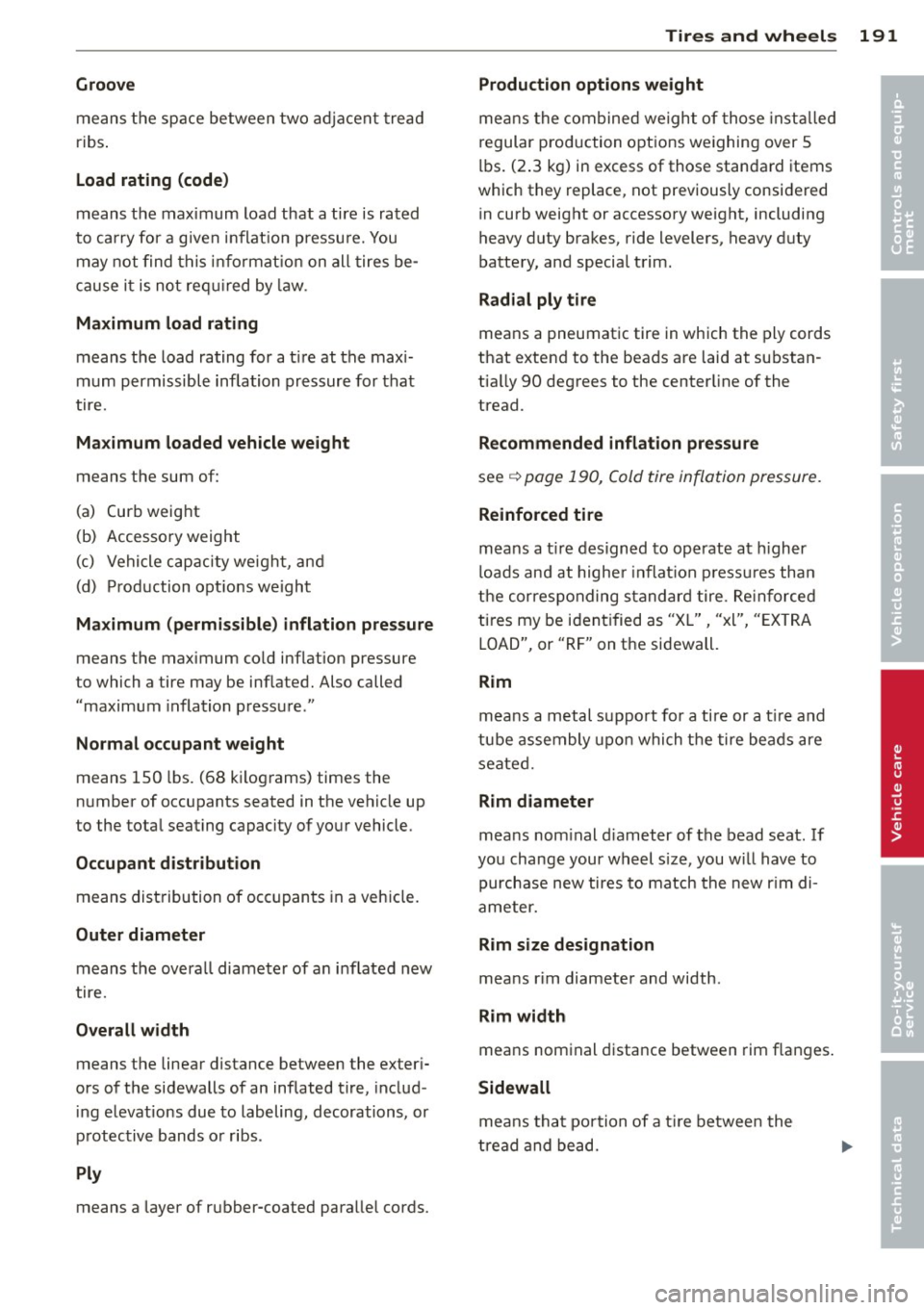
Groove
means the space between two adjacent tread
ribs.
Load rating (code)
means the maximum load that a tire is rated
to carry for a g iven inflation pressure. You
may not find this information on all tires be
cause it is no t req uired by law.
Maximum load rating
means the load rating for a t ire at the max i
mum permissible inflation pressure for that
tire.
Maximum loaded vehicle weight
means the sum of:
(a) Curb weight
(b) Accessory weight
(c) Vehicle capacity weight, and
(d) Production options weight
Maximum (permissible) inflation pressure
means the maximum cold inflation pressure
to which a tire may be inflated. Also called "maximum inflation pressure."
Normal occupant weight
means 150 lbs. (68 kilograms) times the
number of occupants seated in the vehicle up
to the total seating capacity of your vehicle.
Occupant distribution
means distribution of occupants in a vehicle.
Outer diameter
means the overa ll diamete r of an inflated new
tire.
Overall width
means the linear distance between the exteri
ors of the sidewalls of an inflated tire, includ
in g elevations due to labeling, decorations, or
protective bands or ribs.
Ply
means a layer of rubber-coated parallel cords.
Tires and wheels 191
Production options weight
means the combined weight of those installed
regular production options we ighing over 5
lbs. (2.3 kg) in excess of those standard items
which they replace, not previously considered
in curb weight or accessory weight, including
heavy duty brakes, ride levelers, heavy duty
battery, and special trim.
Radial ply tire
means a pneumatic tire in wh ich the ply cords
that extend to the beads are laid at substan
tia lly 90 degrees to the center line of the
tread .
Recommended inflation pressure
see ¢ page 190, Cold tire inflation pressure.
Reinforced tire
means a t ire designed to operate at higher
loads and at higher inflat ion pressures than
the corresponding standard tire. Reinforced
tires my be identified as "XL", "xl", "E XTRA
LOAD", or "RF" on the sidewall.
Rim
means a metal support for a tire or a tire and
tube assembly upon which the tire beads are
seated.
Rim diameter
means nom inal d iameter of the bead seat. If
you change your wheel s ize, you will have to
purchase new tires to match the new rim di
ameter.
Rim size designation
means r im diameter and width .
Rim width
means nominal distance between rim flanges .
Sidewall
means that portion of a tire between the
tread and bead. •
•
Page 195 of 244

Tires and wheels 193
Occupant loading and distribution for vehicle normal load for various designated seating
capacities
Designated seating capacity, Vehicle normal load, Normally loaded vehicle,
occupant distribution
number of occupants number of occupants
2 2 2 in front
Cold tire inflation pressure
Tire pressure affects the overall handling, performance and safety of a vehicle.
Fig. 149 Tir e pressure label: located on driver 's s ide B·
pillar
Tire pressure generally refers to the amount
of air in a tire that it needs it to do its job and
safely carry the combined load of the entire
vehicle and its contents . Tire pressure is
measured in kilopasca ls (kPa), the interna
tional measuring unit and in pounds pe r
square inch (PSI). Tire pressure is based in
part on the vehicle's design and load limit -
the greatest amount of weight that the vehi
cle can carry safe ly and the t ire size . The prop
er tire pressure is frequent ly referred to as the
"recommended cold tire inflation pressure."
Air in the tires expands when the tire heats up
because of internal friction when it flexes in
use . The tire pressu re is higher when the tire
has warmed up than when it is "cold ."
It is the
in flat ion p ressure i n a "cold" tire that counts.
Therefo re, you shou ld neve r let air out of a
warm tire to ma tch "cold tire inflat ion pres
sure" recommendations. The tires would then
be underinflated and could fail suddenly.
Maintaining proper tir e pressure is one of the
most impor tant things you can do to help
avoid sudden tire failure. Underinflated tires
are a ma jor cause of s udden tire failure . Keep·
ing tires at the right pressure is also impor
tant for safe and responsive vehicle handling,
-tD
-
---------------------.. ,;
•(==.: I :::; I :,,. I)@ gi n. ............ .,_____, .... -.ito._.. ____ .... _ ...
&..p0idit,101111-~- -.,...,....- -..... ~ .... ..
-··-.....
-
-Dlst<:OURS
- KPA.. a PSI
- KPA..
a PSI
- KPA..
a PSI
Fig. 150 Tire pressu re labe l
traction, braking and load carrying. Tire pres
sures are particularly important when the
vehicle is being driven at higher speeds, and
then especially when heavily loaded even
within the permissible load-carrying capaci
ties approved for your vehicle.
The recommended tire pressures for your Audi
depend on the kind of tires on your ve hicle
and the number of passengers and/o r amount
of luggage you will be transporti ng.
The tire pressure label is located on the driv
er's side B-pillar . The tire pressure labe l lists
the recommended cold tire inflat io n pre ssures
for the vehicle at its maximum capacity
weight and tires that were on your veh icle at
t he time it was manufactured.
If you wish to improve comfort when operat
ing the vehicle at normal load (up to 2 occu
pants), you can adjust tire pressures to those
specified for normal vehicle load. Before op
erating the vehicle at maximum load, you
must increase the tire pressures to those
specified for maximum vehicle load
¢ &.
Bear in mind that the tire pressure monitoring
system can only monitor the tire pressures
II>
Page 196 of 244
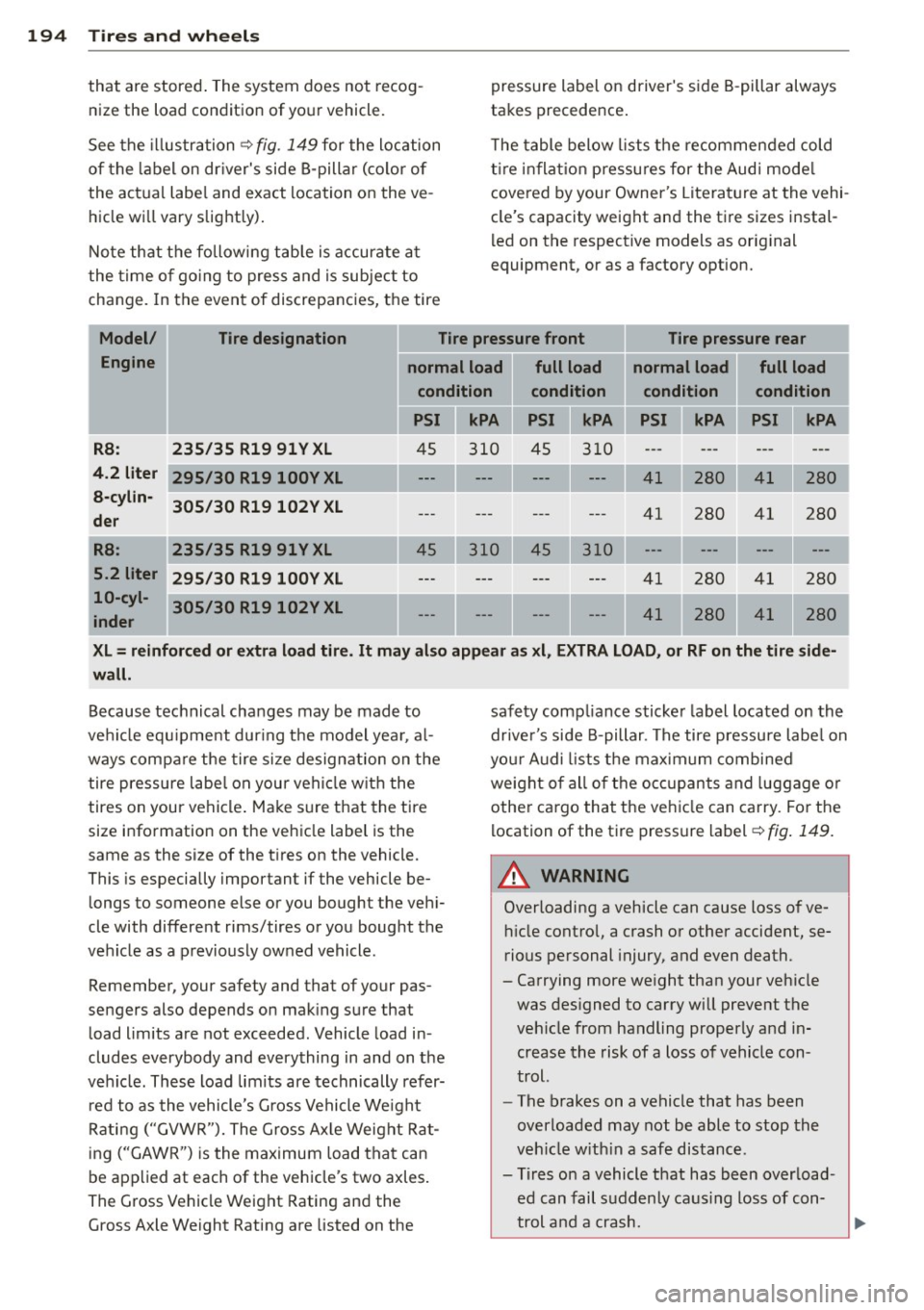
194 Tire s and wheel s
that are stored . The system does not recog
nize the load cond ition of your vehicle.
See the il lustration ~
fig. 149 for the location
of the label on dr iver's side 8-pillar (color of
the actua l labe l and exact location on the ve
hicle wi LL vary slightly).
Note that the followi ng tab le is accurate at
the time o f go ing to press and is subject to
change. In the event of discrepancies, the tire pressure label on driver's s
ide 8 -pillar always
takes precedence .
T he table below l ists t he recommended cold
t ire inflat ion pressu res for the Aud i mode l
covered by your Owner's Literat ure at the vehi
cle's capacity weight and the tir e sizes i nstal
l ed on the respective models as orig inal
equipment, or as a facto ry option.
I Model / \I Tire designation
Tire pressure front Tire pressure rear I
Engine
normal load full load normal load full load
condition condition condition condition
PSI II kPA PSI II kPA PSI ]I kPA
PSI II kPA
RS: 235/35 R19 91 Y XL 45
310 45 310
4 .2 liter
295 /30 R19 lOOY X L 280
8-c ylin-
305/30 R1 9 102V
XL
der 41
280 41
280
RS: 235/35 R19 91 Y XL 45
5.2 liter 295 /30 R19 l00Y XL 41 280 41
280
10-cyl-
305 /30 R19 102V XL
inder 41 280 41 280
--XL= reinforc ed or extra load tire. It may also a ppear as xl , EXTRA LOAD, or RF on the tire side·
wall.
Because tec hnical changes may be made to
ve hicle equ ipment dur ing the model yea r, a l
ways compare the tire size designation on the
tire pressure labe l on your vehicle w ith the
tires on your vehicle . Make s ure that the t ire
size information on the ve hicle label is the
same as the size of the tires on the vehicle.
This is especially important if the vehicle be
longs to someone else or you bough t the veh i
cle with different rims/tires or you bought the
ve hicle as a previously owned vehicle .
Remember, your safety and that of your pas
sengers also depends on mak ing sure that
load limits are not exceeded . Vehicle load in
cludes everybody and everything in and on the
vehicle. These load lim its are technically refer
r ed to as the vehicle 's Gross Vehicle We ight
Rating ("GVWR"). The G ross Ax le Weight Rat
ing ("GAWR") is the maximum load that can
be applied at each of the vehicle's two axles .
The Gross Vehicle Weight Rating and the
G ross Axle Weight Rating are listed on the safety compl
iance sticker label located on the
driver's side 8-pillar. The tire p ressure labe l on
yo ur Audi lists the max im um combined
weight of all o f the occ upants and luggage or
othe r ca rgo that the vehicle can carry. Fo r the
location of the tire pressure label
~ fig . 149.
A WARNING
Overloading a vehicle can cause loss of ve
h icle contro l, a crash or other accident, se
rious personal injury, and even death.
- Carrying more we ight than your veh icle
was designed to carry will prevent the
veh icle from handling properly a nd i n
crease the risk of a loss of vehicle con
trol.
- The brakes on a vehicle that has been
overloaded may not be able to stop the
veh icle w ith in a safe distance.
- Tires on a vehicle that has been overload
ed can fail suddenly ca using loss of con
trol and a crash.
Page 198 of 244
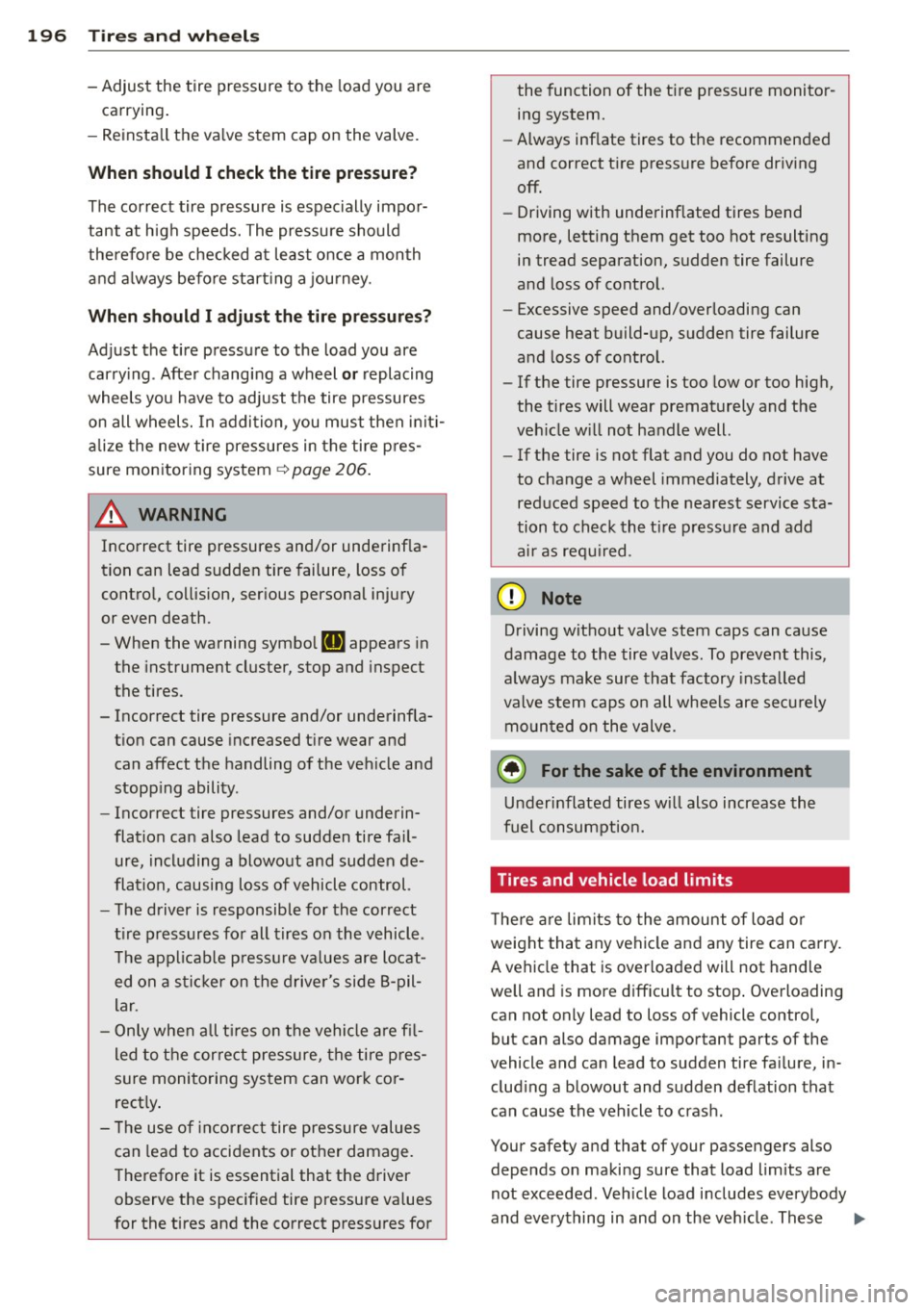
196 Tire s and wheel s
-Adjust the tire pressure to the load you are
carrying.
- Reinsta ll the va lve stem cap on the valve .
When should I check the tire pres sur e?
The correct tire pressure is especially impor
tant at high speeds. The pressure should
therefore be checked at least once a month
and a lways before starting a journey.
When should I adjust th e tir e pre ss ures ?
Adjust the tire pressure to the load you are
carry ing . After changing a wheel
o r replacing
wheels you have to adjust the tire pressures
on all wheels. In addition , you must then init i
alize the new tire pressures in the tire p res
sure mon itoring system ¢
page 206.
& WARNING
Incorrect tire pressures and/or underinf la
tion can lead sudden tire failure, loss of
contro l, collision, serious personal injury
or even death.
- When the warning symbo l
(11 appears in
the instrument cluster, stop and inspect
the tires .
- Incorrect tire pressure and/or underinfla
tion can cause increased tire wear and
can affect the handling of the veh icle and
stopp ing ability .
- Incorrect tire pressures and/or underin
flation can also lead to sudden tire fa il
ure, including a blowout and sudden de
flation, causing loss of vehicle control.
- The driver is responsible for the cor rect
t ire pressures for all tires on the vehicle .
T he applicable p ressu re values are locat
ed on a stic ker on the d rive r's side 8 -pil
lar .
- Only when all t ires on the vehicle a re fi l
led to the correct pressure, the tire p res
sure monitoring system can work cor
rect ly .
- The use of incorrect tire pressure values
can lead to accidents or other damage.
T herefore it is essential that the driver
observe the specified tire pressure va lues
for the tires and the correct press ures for the function of the ti re p
ress ure monitor
ing system.
- Always inflate tires to the recommended
and correct t ire pressure before dr iv ing
off.
- Driving with underinflated tires bend
more, letting them get too hot resulting
in tread separation, sudden tire failure
and loss of control.
- Excessive speed and/overloading can
cause heat build-up, sudden tire failure
and loss of control.
- If the tire pressure is too low or too high,
the t ires will wear prematurely and the
veh icle w ill not handle well.
- If the tire is not flat and you do not have
to change a wheel immediately, drive at
reduced speed to the nearest service sta
tion to check the t ire p ressure and add
ai r as req uired .
@ Note
Driving w ithout valve stem caps can cause
damage to the tire valves. To prevent this ,
always make sure that factory insta lled
valve stem caps o n all whee ls are se curely
moun ted on the valve.
@ For the sake of the environment
Underinflated tires w ill also increase the
fuel consumption.
Tires and vehicle load limits
T he re a re limits to the amount of load or
weight that any vehicle and any tire can carry.
A vehicle that is overloaded will not handle
well and is more d ifficu lt to stop . Overloading
can not only lead to lo ss of vehicle control,
but can also damage impor tant parts of the
vehicle and ca n lead to sudden tire fa ilure, in
clud ing a blowout and sudden deflation that
can cause the vehicle to cras h.
Your safety and that of your passengers also depends on making sure that load limits a re
not exceeded . Vehicle load i ncludes eve rybody
and everything in and on the veh icle . These .,..
Page 201 of 244
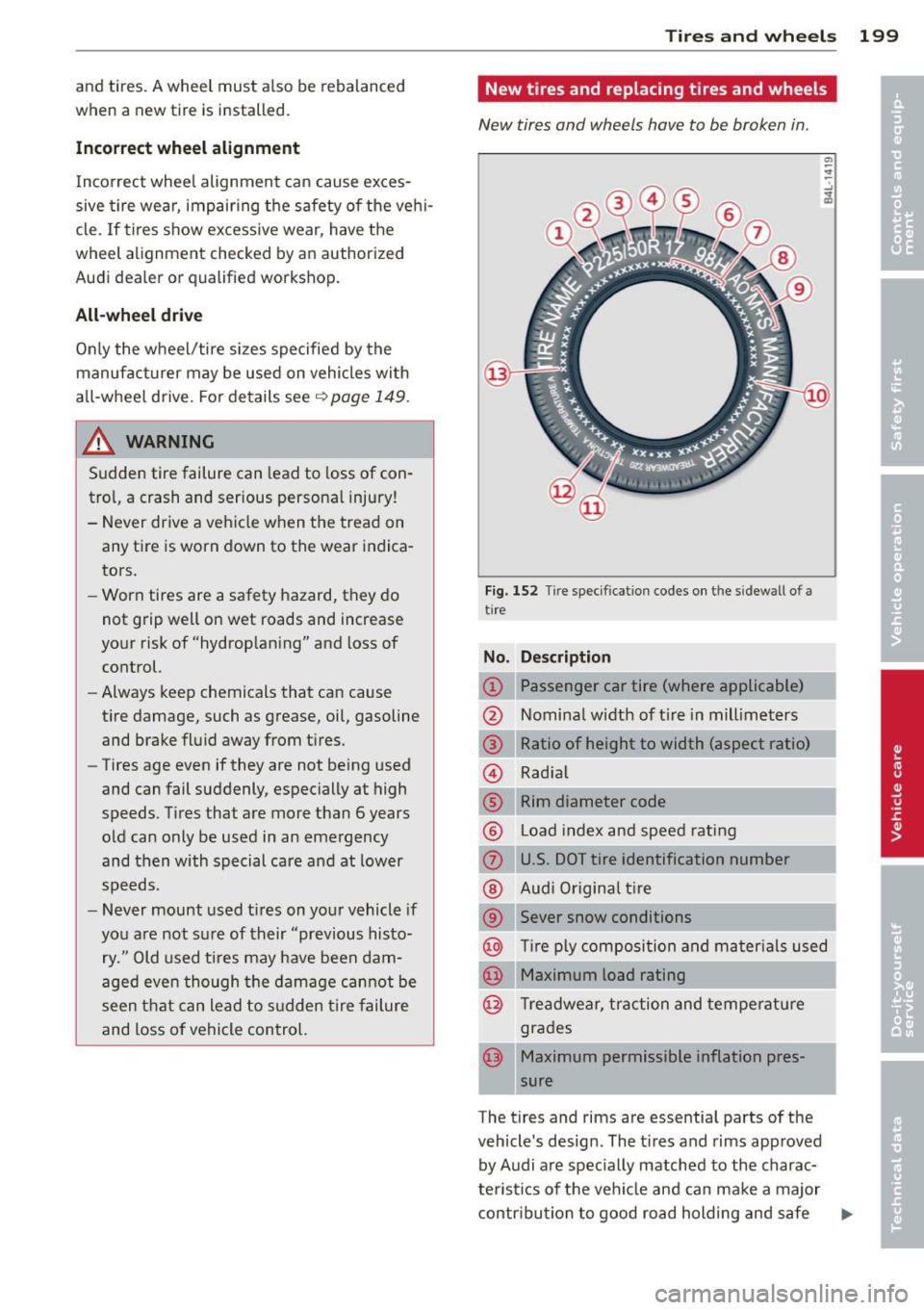
and tires. A wheel must also be rebalanced
when a new tire is installed.
Incorrect wheel alignment
I nco rrect whee l alignment can cause exces
sive tire wea r, impair ing t he safety of the vehi
cle. If tires show excess ive wear, have the
wheel alignment checked by an authorized
Audi dealer or qualified workshop.
All-wheel d rive
Only the wheel/tire sizes specified by the
manufacturer may be used on vehicles wi th
all-wheel drive. For details see
<:!) page 149.
A WARNING
Sudden tire failure can lead to loss of con
tro l, a crash and serious persona l injury!
- Never drive a veh icle when the tread on
any t ire is worn down to the wear indica
tors.
- Worn tires are a safety hazard , they do
not grip well on wet roads and increase
your risk of"hydrop lan ing" and loss of
co ntrol.
- Always keep chemicals that can cause
tire damage, such as grease, oil, gasoline
and brake fl uid away from t ires.
- Tires age even if they are not being used
and can fail suddenly, especially at high
speeds. Tires that are more than 6 years
old can only be used in an emergency
and then with special care and at lower
speeds.
- Never mount used tires on yo ur vehicle if
you are not sure of their "previous histo
ry." Old used tires may have been dam
aged even though the damage cannot be
seen that can lead to s udden tire failure
and loss o f vehicle control.
Tires and wheels 199
New tires and replacing tires and wheels
New tires and wheels hove to be broken in .
Fig. 152 Tir e spec ificat io n codes on t he s idewall o f a
tire
No. De scription
CD Passenger car tire (where applicable)
@ Nomina l width of t ire in mill imeters
® Ratio of height to width (aspect ratio)
© Rad ia l
® Rim diameter code
® Load index and speed rating
(f) U.S. DOT tire identification number
® Aud i O rigina l tire
® Sever snow conditions
@ Tire p ly composi tion and mater ials used
@ Maximum load rating
@ T readwear, tracti on and temperature
grades
@ Maximum permissible inflation pres-
sure
The tires and rims are essentia l parts of the
vehicle 's design . The t ires and rims app roved
by A udi are spec ially matched to the charac
teristics of the vehicle and can ma ke a major
contr ibu tion to good road holding and safe .,.
•
Page 204 of 244

202 Tire s and whee ls
cause ma lfunction of the tire pressure moni
toring system, and is not recommended (cord
materia l information in molded on the tire
sidewall).
A lways check your tire pressure monitoring
system indicator after replacing one or more
tires on your vehicle . If the tire pressure mon i
toring system indicator flashes, or is on, your
system is not working properly.
A WARNING
-Us ing incorrect or unmatched tires and/
or wheels or improper tire and wheel
combinations can lead to loss of cont rol,
co llision and serious persona l injury.
- Always use tires, rims and wheel bo lts
that meet the specifications of orig inal
factory-installed t ires or other combina
t ions that have been specifically ap
proved by the vehicle manufac turer .
- T ires age even if they are not be ing used
and can fail suddenly, especially at high
speeds. Tires that are more than 6 years
o ld can only be used in an emergency
and then with special care and at lower
speeds.
- Never mount used tires on yo ur vehicle if
you are not sure of their "previous histo
ry." Old used tires may have been dam
aged even though the damage cannot be
seen that can lead to sudden tire failure
and loss of vehicle control.
- Only the wheel/tire s izes specified by the
manufacturer may be used on veh icles
with all-wheel dr ive.
- Never drive faster than the maximum
speed for which the tires on your veh icle
are rated because ti res that are driven
fas ter than their rated speed can fail
sudden ly.
- Overloading t ires cause heat build-up,
sudden tire failure, incl uding a blowout
and sudden deflation and loss of control.
- Temperature grades app ly to tires that
are prope rly inflated and not over or un
derinflated. -
For technica l reasons it is not always
possible to use wheels from other
vehicles -in some cases not even wheels
from the same veh icle model.
- Do not use run-flat tires on your vehicle.
Using run-flat tires can lead to veh icle
damage or crashes .
(D Note
-For technical reasons, it is not generally
possible to use the wheel rims from oth
er veh icles . Th is can hold true for wheels
of the same vehicle type .
- If you should put different wheels and
tires on your veh icle (e.g. winter wheels
and tires), you must be certain that the
wheels and tires are compatible with the
tire pressure monitoring system. Other
w ise the system will register a malfunc
tion and a fau lt message w ill be dis
played. For more information, contact
your authorized Audi dealer.
(D Note
- When installing new tires, be care ful not
to damage the valves or tire pressure
monitoring system sensors.
- Never drive without the valve stem cap.
The va lves co uld get damaged.
- If the sensors must be replaced, then
the valve must also be replaced at the
same time.
@ For the sake of the environment
Dispose of o ld tires in accordance with the
l ocal requirements .
(D Tips
Tires with the identification "ROl'' have
been specially matched wi th you r A udi. We
recommend using on ly these tires because
they meet the highest standards regarding
safety and driving characteristics when used correctly. Your authorized Audi R8
dealer w ill gladly provide you with more
i nformat ion.
Page 205 of 244
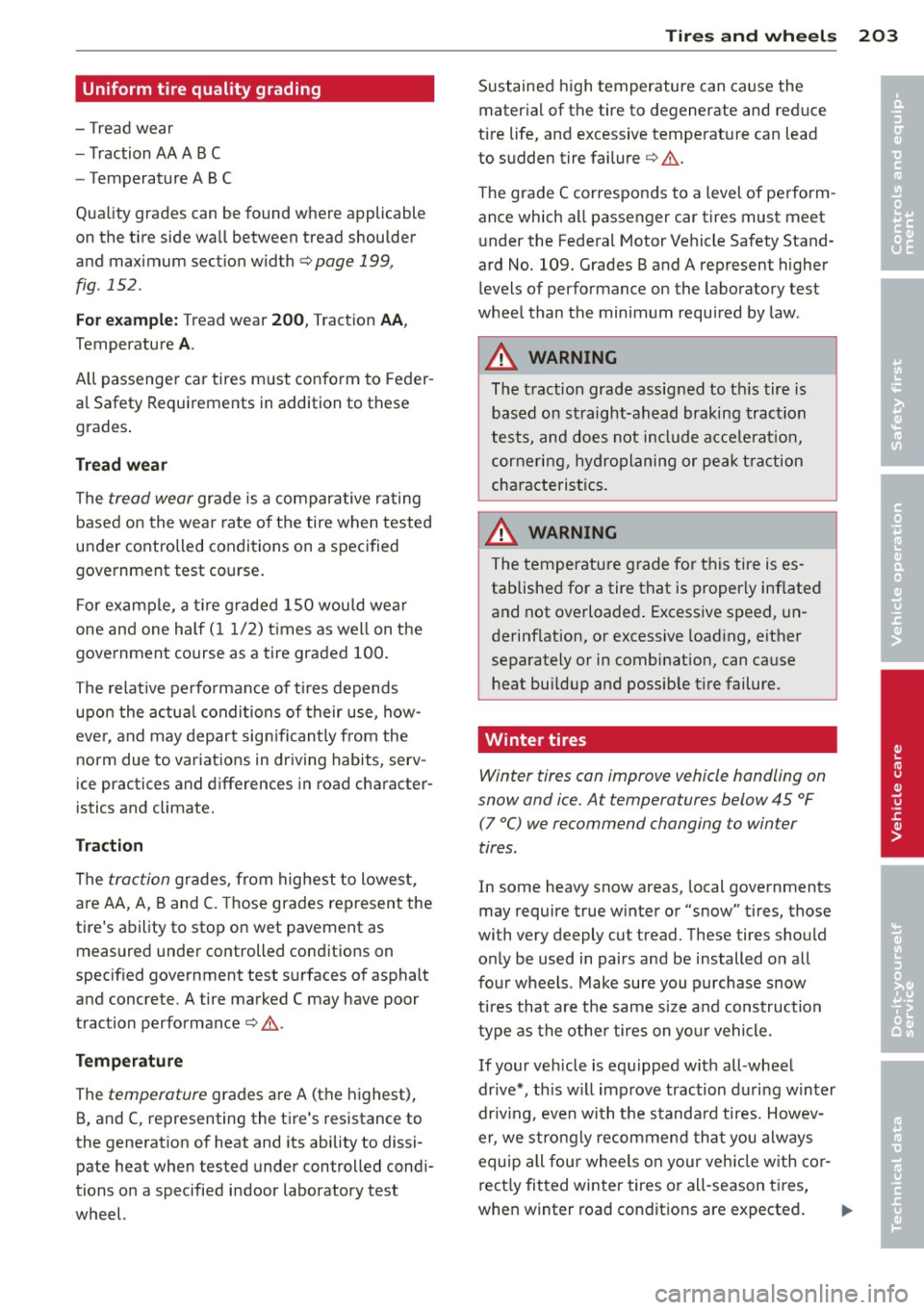
Uniform tire quality grading
- T read wear
- T raction AA A BC
- Temperature ABC
Qua lity grades can be found where applicable
on the tire side wa ll between tread shoulder
and maximum sect ion width
c::> page 199,
fig . 152.
Fo r exa mpl e: Tread wear 200 , Traction AA,
Temperature A.
All passenge r car tires must confo rm to Feder
a l Safety Requirements in addition to these
grades .
Tread we ar
The tread wear grade is a comparative rating
based on the wear rate of the tire when tested
under controlled conditions on a speci fied
government test course .
F or example, a t ire graded 150 wou ld wear
one and one half (1 1/2) t imes as well on the
government course as a tire graded 100 .
The rela tive pe rfo rmance of tires depends
upon the a ctua l conditions of their use, how
ever, and may depart sign ifican tly from the
norm due to variations in driving habits, serv
ice practices and differences in road character
istics and climate.
Traction
The traction grades , from highest to lowest,
a re AA, A, Band
C. T hose grades represent the
tire's ability to stop on wet pavement as
measured under controlled conditions on
specified government test surfaces of asphalt
and concrete. A tire marked C may have poor
traction performance
c::> &. .
Temp erature
The temperature grades are A (the highest),
B, and C, representing the tire's resistance to
the generat ion of heat and its ability to dissi
pate heat when tested under controlled condi
tions on a specified indoor laboratory test
wheel.
Tire s an d wheel s 203
Sustained high temperature can cause the
materia l of the tire to degenerate and reduce
tire life, and excessive temperat ure can lead
to sudden tire failure
c::> &, .
The grade C corresponds to a level of pe rform
ance which all passenger car tires must meet
u nder the Federal Motor Vehicle Safety Stand
ard No. 109. Grades Band A represent higher levels of performance on the laboratory test
whee l than the minimum required by law.
A WARNING
The t raction grade assigned to th is tire is
based on straight-ahead braking traction
tests, and does not include accele rat ion,
cornering, hydroplaning or peak t raction
characterist ics.
A WARNING ~
The temperature g rade for this tire is es-
tablished for a tire that is properly inflated
and not overloaded . Excessive speed, un
derinflation, or excessive loading, e ither
separately or in combinat ion, can ca use
heat bui ldup and possible tire failure.
Winter tires
Winter tires can improve vehicle handling on
snow and ice . At temperatures below 45 °F
(7 °C) we recommend changing to winter
tires .
In some heavy snow areas, local governments
may require true w inter or "snow" tires, those
with very deeply cut tread. These tires should
o nly be used in pairs and be installed on all
fou r wheels . Make sure you purchase snow
t ir es that a re t he same s ize and construction
type as the othe r ti res on you r vehicle.
If your vehicle is equipped w it h all -wheel
drive*, th is w ill imp rove traction during w inter
driv ing , even with the standa rd tires . Howev
er, we strongly recommend that you always
equip all four whee ls o n your ve hicle w ith cor
rect ly fitted winter tires o r all-season t i res,
when winter road conditions are expected .
ll-
•
•
Page 208 of 244
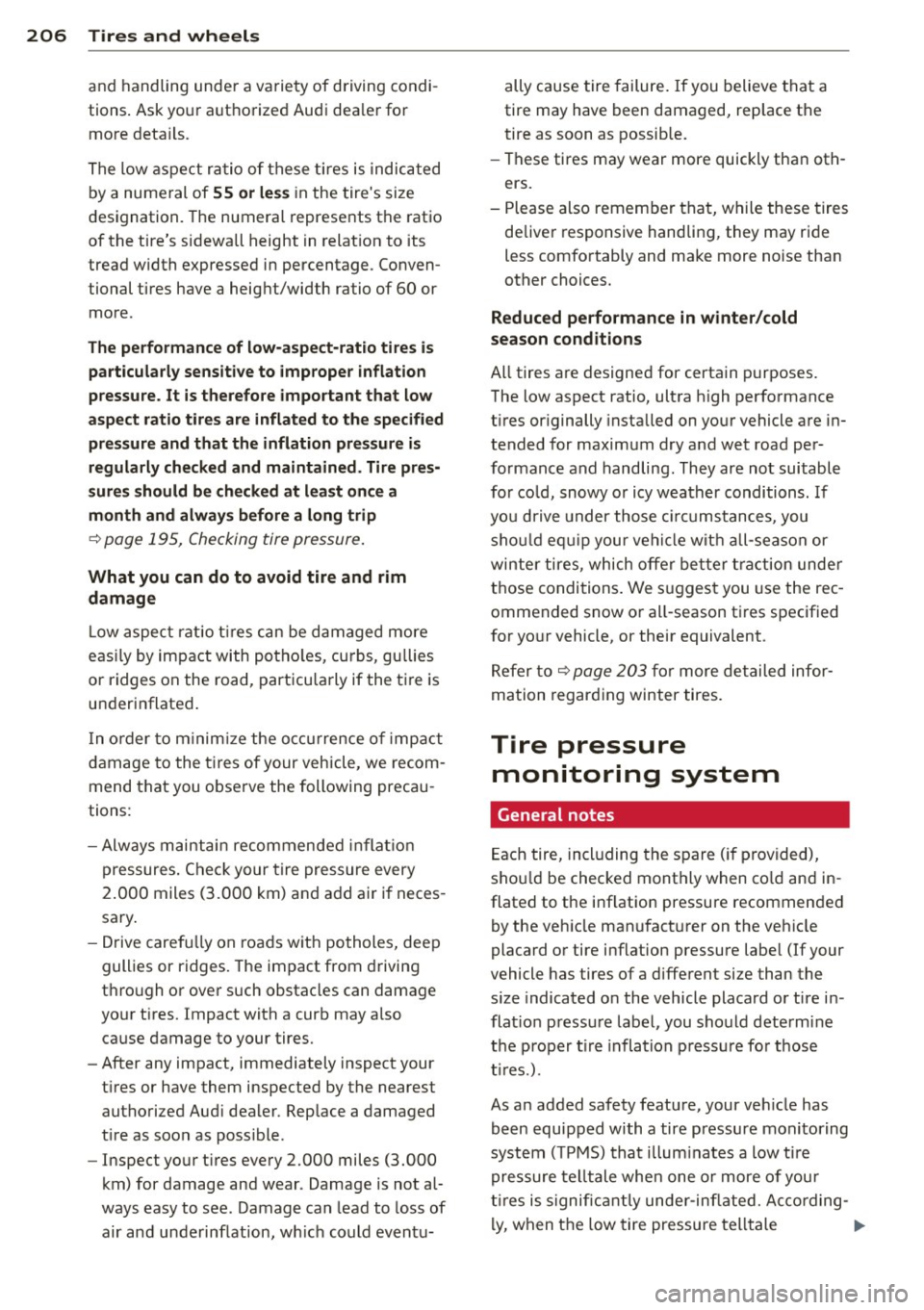
206 Tires and wheels
and handling under a variety of driving condi
tions. Ask your authorized Audi dea ler for
more details.
The low aspect ratio of these tires is indicated
by a numeral of
55 or less in the tire's size
designation. The numeral represents the ratio
of the tire's sidewall height in relation to its
tread width expressed in percentage . Conven
tional tires have a height/width ratio o f 60 or
more .
The performance of low-aspect-ratio tires is
particularly sensitive to improper inflation
pressure. It is therefore important that low
aspect ratio tires are inflated to the specified
pressure and that the inflation pressure is regularly checked and maintained . Tire pres·
sures should be checked at least once a
month and always before a long trip
~ page 195, Checking tire pressure.
What you can do to avoid tire and rim
damage
L ow aspect ratio t ires can be damaged more
ea5i ly by impact with potho le5, curb5, gullie5
or ridges on the road, particularly if the tire is
underinflated .
In order to minimize the occur rence of impact
damage to the tires of your vehicle, we recom
mend that you observe the following precau
tions :
- Always maintain recommended inflation
pressures. Chec k your tire pressure every
2.000 miles (3.000
km) and add air if neces
sary .
- Drive carefu lly on roads with potholes, deep
gullies or ridges. The impact from driving
t h ro ugh or over such obstacles can damage
yo ur tir es. Impact with a curb may also
cause damage to your tires.
- After any impact, immediately inspect your
tir es or have them inspected by the nearest
authorized Aud i dealer. Replace a damaged
t ir e as soon as possible.
- Inspect your t ires every 2.000 miles (3.000
km) for damage and wear. Damage is not al
ways easy to see . Damage can lead to loss of
air and underinflation, wh ich could eventu- ally cause
tire failure. If you believe that a
tire may have been damaged, replace the
tire as soon as possible.
- These tires may wear more quickly than oth
ers.
- Please also remember that, while these tires
deliver responsive handling, they may ride
less comfortably and make more noise than
other choices.
Reduced performance in winter/cold
season conditions
All tires are designed for certain purposes.
The low aspect ratio, ultra h igh performance
t ir es or iginally installed on your vehicle are in
tended for maximum dry and wet road per
fo rmance and handling . They are not suitable
for cold, snowy or icy weather conditions. If
you drive under those circumstances, you
sho uld equ ip your vehicle with all-season or
winter tires, which offer better traction unde r
those conditions. We suggest you use the rec
ommended snow or all-season t ires specified
for your vehicle, or their equivalent .
Refer to~
page 203 for more de tailed infor
mation regarding winter tires.
Tire pressure
monitoring system
General notes
Each tire, including the spare (if provided),
sho uld be checked monthly when co ld and in
flated to the inflation pressure recommended
by the veh icle manufact urer on the vehicle
placard or tire inflation pressure label (If your
vehicle has tires of a different size than the
s ize indicated on the vehicle placard or tire in
flat io n pressure label, you should dete rmine
the proper t ire inflation pressure for those
t i r es.).
As an added safety feature, your veh icle has
been equipped with a tire pressure monitoring
system ( TPMS) that illum inates a low tire
pressure telltale when one or more of you r
t ir es is significantly under-inflated. According -
ly, when the low tire pressure telltale ..,.